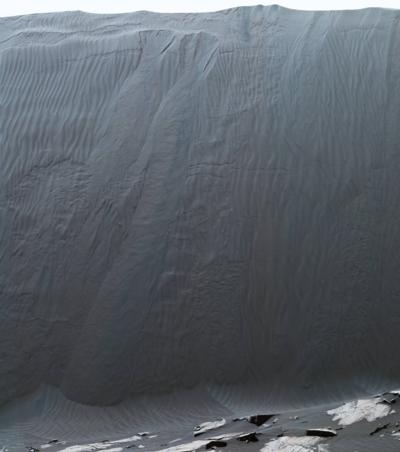Fri, Jan 08, 2016
Observes Slip Face Of Dune For The First Time
NASA's Curiosity Mars rover, partway through the first up-close study ever conducted of extraterrestrial sand dunes, is providing dramatic views of a dune's steep face, where cascading sand has sculpted very different textures than the wavy ripples visible on the dune's windward slope.

Researchers are using Curiosity to examine examples of the Bagnold Dunes, a band of dark sand dunes lining the northwestern flank of Mt. Sharp, the layered mountain the rover is climbing. A characteristic that sets true dunes apart from other wind-shaped bodies of sand, such as drifts and ripples previously visited by Mars rovers, is a steep, downwind slope known as the slip face. Here, sand blowing across the windward side of the dune suddenly becomes sheltered from the wind by the dune itself. The sand falls out of the air and builds up on the slope until it becomes steepened and flows in mini-avalanches down the face.
The mission's dune-investigation campaign is designed to increase understanding about how wind moves and sorts grains of sand, in an environment with less gravity and much less atmosphere than well-studied dune fields on Earth. The Bagnold Dunes are active. Sequential images taken from orbit over the course of multiple years show that some of these dunes are migrating by as much as a yard, or meter, per Earth year.
Curiosity has not caught a sand slide in action, but the rover's images of the Namib Dune slip face show where such slides have occurred recently. These dunes likely are most active in Mars' southern summer, rather than in the current late-fall season.

A few days of rover operations were affected in December due to an arm-motion fault, diagnosed as a minor software issue. Normal use of the arm resumed Dec. 23.
Curiosity has been working on Mars since early August 2012. It reached the base of Mount Sharp in 2014 after fruitfully investigating outcrops closer to its landing site and then trekking to the mountain. The main mission objective now is to examine successively higher layers of Mount Sharp.
(Images provided with NASA news release)
More News
Takeoff Roll The process whereby an aircraft is aligned with the runway centerline and the aircraft is moving with the intent to take off. For helicopters, this pertains to the act>[...]
“We’re proud of the hard work that went into receiving this validation, and it will be a welcome relief to our customers in the European Union. We couldn’t be mor>[...]
"Aircraft Spruce is pleased to announce the acquisition of the parts distribution operations of Wag-Aero. Wag-Aero was founded in the 1960’s by Dick and Bobbie Wagner in the >[...]
IDENT Feature The special feature in the Air Traffic Control Radar Beacon System (ATCRBS) equipment. It is used to immediately distinguish one displayed beacon target from other be>[...]
Aero Linx: Pararescue Air Force Pararescuemen, also known as PJs, are the only DoD elite combat forces specifically organized, trained, equipped, and postured to conduct full spect>[...]
 ANN's Daily Aero-Term (05.10.24): Takeoff Roll
ANN's Daily Aero-Term (05.10.24): Takeoff Roll Aero-News: Quote of the Day (05.10.24)
Aero-News: Quote of the Day (05.10.24) Aero-News: Quote of the Day (05.11.24)
Aero-News: Quote of the Day (05.11.24) ANN's Daily Aero-Term (05.11.24): IDENT Feature
ANN's Daily Aero-Term (05.11.24): IDENT Feature ANN's Daily Aero-Linx (05.11.24)
ANN's Daily Aero-Linx (05.11.24)




